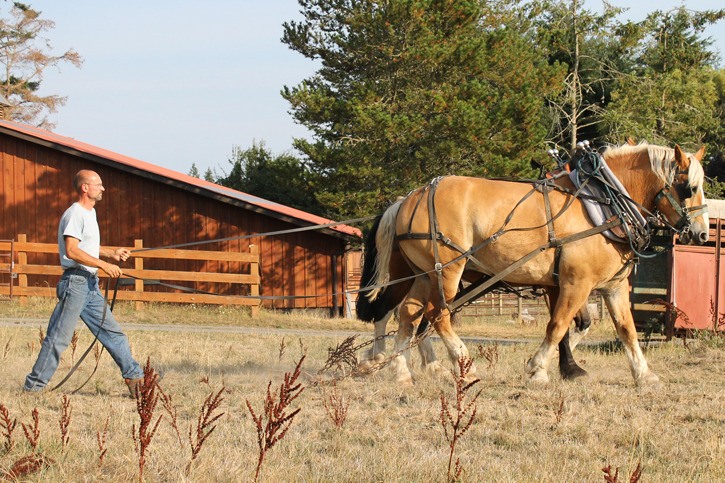Before moving to the island, Greg Lange described himself as an endurance junkie. His habits included marathons, extreme skiing, intense hikes and basically “anything that had to do with endurance.” So it’s fitting that he got into working with draft horses, which requires an immense amount of strength and fortitude.
“They’re just big power athletes, is what they are,” said Lange, who previously worked as a healthcare administrator, as he ran his hand along Sonny’s back, ending with a pat. Sonny, the six foot tall, 2,000 pound American Belgian draft horse stands quietly, brushing his head against the pine tree and sighing occasionally. Sonny’s daughter Toots, a half Belgian and half Clydesdale, stands next to him calmly, her dark mane warm in the summer sun.
“It’s always a good thing when they sigh, it means they don’t have any anxiety and the world’s a pleasant place,” Lange said.
Lange’s business is Draft Works Logging, located on San Juan Island at Talking Horse Farm off Roche Harbor Road. He moved here for the tight-knit community with agricultural roots.
Though Lange is new to the island, draft horses are most certainly not. According to Kevin Loftus of the San Juan Island Historical Museum, draft horses were regularly used for heavy duty work on the island for plowing and logging.
A unique use for them was loading large glacial rocks in what was called a “stone boat,” or a metal sled, to clear lands for agricultural use. Loftus said the piles of removed glacial rocks can still be seen on the side of some fields, especially at American Camp where they’ve been specifically preserved.
“None of us here are more than two or three generations removed from having used these animals,” Lange said. “They’re such noble creatures, it’s hard not to get caught up in that.”

Lange contracts to small farmers and property owners to thin out, log, till and plow acreage with his draft horses. According to the United States Department of Agriculture, using horses for logging leaves significantly less soil compaction, wildlife disturbance and leaf and tree growth damage than large tractors and other mechanized methods of removal.
Conrad Berthold is one such property owner with 28 forested acres off of Boundary Point Road and is part of the Designated Forest Land program, where landowners get reduced property tax for meeting certain requirements. One requirement is to have a forest management plan, which he got through services provided by the Conservation District after an 11 month wait list.
“Part of the plan involves what are the objectives of the homeowners, we want to conserve the forest as much as we can and leave a variety of ages and species of trees and so one of the ways to do that is to do a very selective harvest,” Berthold explained. “One of the things I began to realize was if you bring in a logging company with a lot of machinery, a lot of times the harvest is not as selective as you’d like it to be.”
According to the San Juan County Assessor’s office, 13.5 percent of the county is in the DFL program, a total of 14,813 acres. The county assesses these parcels in a six year cycle that starts again in 2017.
“It’s a program for growing and harvesting trees,” said Bill Shanks, DFL administrator. “You can’t just be in the program and never do the last part concerning the harvest. And that’s not to say it has to be clear-cut, there’s certain management practices that are required to stay compliant in the program to continue to qualify for your land to get this discount.”
Shanks said that those in the DFL program can change their management plan as conditions on their property change. He added that if someone becomes ineligible, he’ll work with the property owner to ensure that they can be eligible again.
“If I see somebody whose property may be out of compliance, I certainly help them to re-qualify and get back on track,” Shanks said. “We aren’t reviewing it to see how many people would be disqualified. I’m really interested in helping the people here.”
Berthold plans for the logging to begin in the fall, and estimates that the process will take two to three years, which he said is good for his situation, because it will provide more time to look at the process of logging.
“We don’t have to go in and identify every tree right now that we’re going to take out,” he said. “A big logging crew could go in there in two weeks and take out all the trees and then some that we want. But it could force decisions to be made about certain things and certain areas that we don’t want to make hastily.”
After cutting the chosen logs, Lange brings in his horses to skid the log out. He balances on a small platform attached to the horses that allows him to guide the horses with soft pressure from the reins and guiding comments of “gee” and “haw.” The trees are cut up into about 30-foot lengths, which means that one tree can take multiple loads. When the horses aren’t working, Lange keeps them fit by training three times a week for a few hours, pulling a log around a field and a container full of rocks.
Berthold commented that many landowners with smaller forest properties would benefit from working with draft horse logging for the reasons above, and said at some point after his operation begins he may let people observe the process and use his property as a type of demonstration forest to let people see how it works.For more info on involvement with the Designated Forestry Land program, call the county assessor’s office 378-2172 or email them at assessor@sanjuanco.comFor a slideshow of Lange and his horses visit www.sanjuanjournal.com



